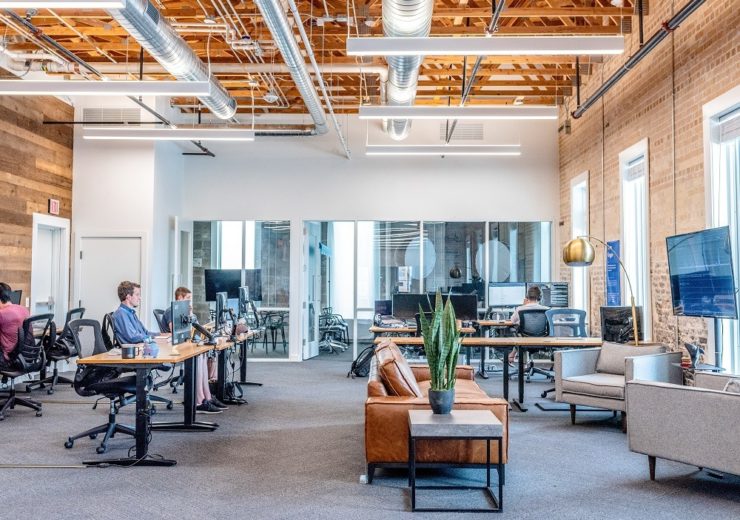
Socially-distanced offices will become a common sight for the foreseeable future once workplaces reopen to staff (Credit: Unsplash/Austin Distel)
As the world gradually prepares for the return to workplaces after many weeks of lockdown, businesses will need to show clear and well thought-out strategies for reopening offices after coronavirus to keep staff onside. Steve Arnold, CEO of employee tracking software provider e-days, discusses.
Governments around the world are beginning to prepare for an easing of lockdown restrictions, and the requirements for businesses are rightly being debated.
Decision-makers across the globe will be urgently tracking scientists’ data (not to mention keeping a close eye on their neighbours) to better understand when offices, restaurants, bars and other venues can re-open, and many people can return to work.
This seems to promise some economic salve. Government schemes to prevent mass unemployment will have to reach an end point at some stage – the Financial Times recently reported that more than 35 million workers in Europe’s five largest economies are having part of their wages paid by the state.
For business owners, however, this is far from the end of the road. It might be tempting to think that with pandemic numbers hopefully under control, employees can get back to doing what they do best, and the effects of the coronavirus will start to dissipate.
Unfortunately, I believe this would not only be a blasé approach in returning what could be an entire workforce to an office, but one that could be highly detrimental to business success – and even dangerous to employee welfare.
Whenever a date is decided for people to return to work, it’s going to be more important than ever for employers to make sure they take practical and intelligent steps to re-integrate their employees.
Why is this and what should companies be doing?
Have a robust sickness strategy in place after coronavirus lockdown for reopening offices
If and when people can head back to offices, it seems unlikely the current coronavirus will have completely disappeared – more likely, it will have been deemed to be at a manageable level.
Therefore, people, including your employees, still have the potential to get ill and carry that infection into the office.

It’s going to become extremely important for companies to log who’s off sick, why they are off sick and, if it’s coronavirus-related, when they first displayed symptoms.
You should then notify others in their office or team so they all know that someone has displayed possible symptoms of Covid-19, and can make conscious decisions around their health and their family’s health – whether that means staying home for a while themselves or not.
This should, and may well be, mandated by a government body. But if it’s not, companies should go “above and beyond” to adopt the practice, especially in light of needing to contain the spread of the virus to vulnerable people.
Get your numbers and timings right for reopening offices after coronavirus lockdown
Especially for the managers of large offices – where in a central business district you might expect hundreds or even thousands of employees to take up a single floor – it shouldn’t need a maths degree to realise that reintroducing everyone to the workplace at the same time isn’t the best idea.
Companies need to be smart about bringing people back in, starting perhaps with a number of volunteers and monitoring them for two weeks to check any impact on mental and or physical health.
Why volunteers? People are not going to be falling over themselves after a long period of relative isolation to be packing onto busy tube trains and buses, then sitting a couple of feet apart from multiple colleagues all day.
So, an all-staff email which says anything like “we expect you all to be in from tomorrow” is not going to do the job.
But an evidence-based approach (“we’ve now had a third of the office in for two weeks and the feedback has been positive”) will do a lot more to reassure staff and make it more likely that you can return to business normality sooner, rather than having people unwilling to come in, needing time off due to anxiety, or even quitting their jobs.
Listen to your staff
On that note, you’ve simply got to listen to your staff’s requirements and understand how you can best help them in the return to work. One of the most quoted lines in the media at the moment is how the pandemic could spell the “end of the office”.
While, personally, I don’t believe that’s going to be the case, we can be sure that staff are more aware than ever of the possibilities of flexible working.
It will be harder and harder for business leaders to paint working from home as an earned luxury – staff will want to make remote working more integral to their relationship with the business.
There are enough studies out there to show that working from home is at least as productive as working in an office, too.

After a lengthy period of not seeing their colleagues, you’d hope that most people will want to spend a bit of time catching up in person with their team. But after that, two days a week working remotely seems a more than likely request for many.
Business owners need to listen to that request – don’t dismiss it out of hand, and have some reasons to back you up if you’re not going to be able to accommodate this.
Get your strategy right for next time
Maybe things weren’t too bad for your company this time around, but I can guarantee there will be areas of dealing with the pandemic that we will all wish we had handled better.
In a world where this sort of situation seems increasingly likely, businesses need a long-term strategy for helping staff manage a period of lockdown.
Evaluating areas that could have run smoother, and policies that have been implemented since lockdown that could remain in place when we do eventually return to business as usual is a great way to ready yourself for employee reemergence into the office.
Ensuring that the appropriate software is in place so that you can effectively report on sickness, while managing and listening to your staff as and when we enter into a period of loosened restrictions will stand you in good stead to meet the challenges of the future.


